AMPK alpha 1 Recombinant Rabbit Monoclonal Antibody [SU03-48]

cat.: ET1608-40
| Product Type: | Recombinant Rabbit monoclonal IgG, primary antibodies |
|---|---|
| Species reactivity: | Human, Mouse, Rat |
| Applications: | WB, IF-Cell, IF-Tissue, FC, IP, IHC-Fr, IHC-P |
| Clonality: | Monoclonal |
| Clone number: | SU03-48 |
| Form: | Liquid |
| Storage condition: | Shipped at 4℃. Store at +4℃ short term (1-2 weeks). It is recommended to aliquot into single-use upon delivery. Store at -20℃ long term. |
| Storage buffer: | 1*TBS (pH7.4), 0.05% BSA, 40% Glycerol. Preservative: 0.05% Sodium Azide. |
| Concentration: | 1ug/ul |
| Purification: | Protein A affinity purified. |
| Molecular weight: | Predicted band size: 64 kDa |
| Isotype: | IgG |
| Immunogen: | Synthetic peptide within Human AMPK alpha aa 501-550 / 559. |
| Positive control: | HeLa cell lysate, MCF7 cell lysate, K-562 cell lysate, 293T cell lysate, HT-29 cell lysate, L-929 cell lysate, C6 cell lysate, 4T1 cell lysate, Neuro-2a cell lysate, RAW264.7 cell lysate, HeLa, L-929, human lung cancer tissue. |
| Subcellular location: | Cytoplasm, Nucleus. |
| Recommended Dilutions:
WB IF-Cell IF-Tissue FC IP IHC-Fr IHC-P |
1:1,000-1:5,000 1:100-1:250 1:50-1:200 1:1,000 Use at an assay dependent concentration. 1:100 1:1,000 |
| Uniprot #: | SwissProt: Q13131 Human | Q5EG47 Mouse | P54645 Rat |
| Alternative names: | 5 AMP activated protein kinase alpha 1catalytic subunit 5 AMP activated protein kinase catalytic alpha 1 chain 5' AMP activated protein kinase catalytic subunit alpha 1 5'-AMP-activated protein kinase catalytic subunit alpha-1 AAPK1 AAPK1_HUMAN ACACA kinase acetyl CoA carboxylase kinase AI194361 AI450832 AL024255 AMP -activate kinase alpha 1 subunit AMP-activated protein kinase, catalytic, alpha -1 AMPK 1 AMPK alpha 1 AMPK alpha 1 chain AMPK AMPK subunit alpha-1 AMPK1 AMPKa1 AMPKalpha1 C130083N04Rik cb116 EC 2.7.11.1 HMG CoA reductase kinase HMGCR kinase hormone sensitive lipase kinase Hydroxymethylglutaryl CoA reductase kinase im:7154392 kinase AMPK alpha1 MGC33776 MGC57364 OTTHUMP00000161795 OTTHUMP00000161796 PRKAA 1 PRKAA1 Protein kinase AMP activated alpha 1 catalytic subunit SNF1-like protein AMPK SNF1A Tau protein kinase PRKAA1 wu:fa94c10 |
Images
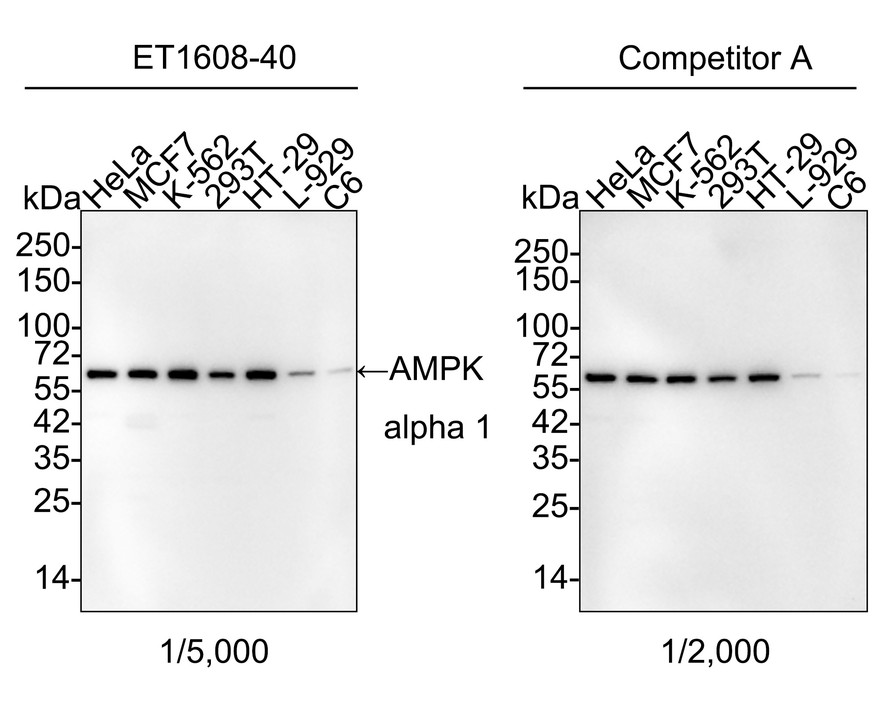
|
Fig1:
Western blot analysis of AMPK alpha 1 on different lysates with Rabbit anti-AMPK alpha 1 antibody (ET1608-40) at 1/5,000 dilution and competitor's antibody at 1/2,000 dilution. Lane 1: HeLa cell lysate (20 µg/Lane) Lane 2: MCF7 cell lysate (20 µg/Lane) Lane 3: K-562 cell lysate (20 µg/Lane) Lane 4: 293T cell lysate (20 µg/Lane) Lane 5: HT-29 cell lysate (20 µg/Lane) Lane 6: L-929 cell lysate (20 µg/Lane) Lane 7: C6 cell lysate (20 µg/Lane) Predicted band size: 64 kDa Observed band size: 64 kDa Exposure time: 1 minute 10 seconds; ECL: K1802; 4-20% SDS-PAGE gel. Proteins were transferred to a PVDF membrane and blocked with 5% NFDM/TBST for 1 hour at room temperature. The primary antibody (ET1608-40) at 1/5,000 dilution and competitor's antibody at 1/2,000 dilution were used in 5% NFDM/TBST at 4℃ overnight. Goat Anti-Rabbit IgG - HRP Secondary Antibody (HA1001) at 1/50,000 dilution was used for 1 hour at room temperature. |
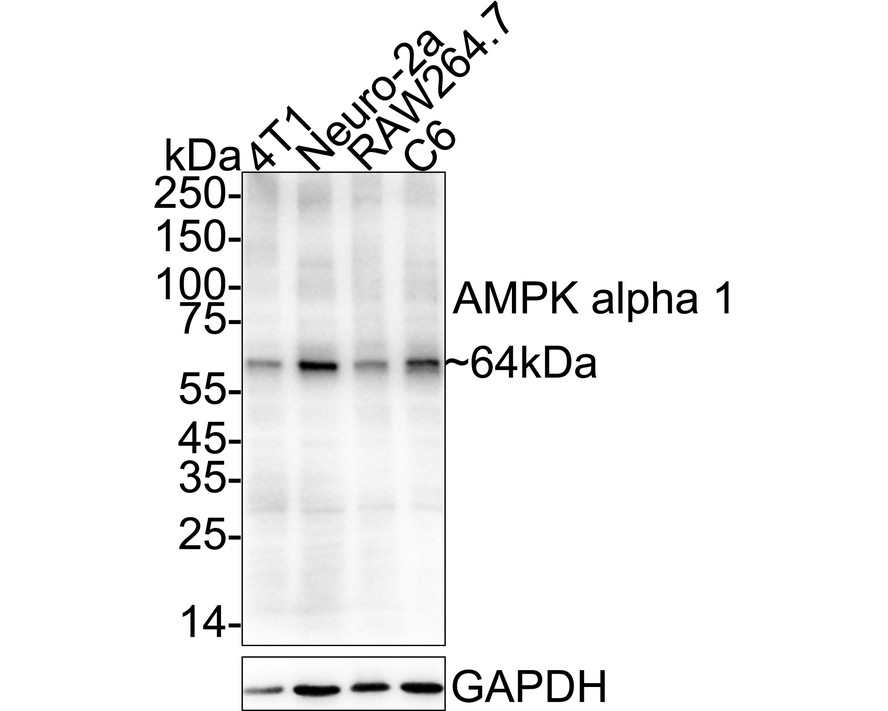
|
Fig2:
Western blot analysis of AMPK alpha 1 on different lysates with Rabbit anti-AMPK alpha 1 antibody (ET1608-40) at 1/1,000 dilution. Lane 1: 4T1 cell lysate (20 µg/Lane) Lane 2: Neuro-2a cell lysate (20 µg/Lane) Lane 3: RAW264.7 cell lysate (20 µg/Lane) Lane 4: C6 cell lysate (20 µg/Lane) Predicted band size: 64 kDa Observed band size: 64 kDa Exposure time: 59 seconds; ECL: K1801; 4-20% SDS-PAGE gel. Proteins were transferred to a PVDF membrane and blocked with 5% NFDM/TBST for 1 hour at room temperature. The primary antibody (ET1608-40) at 1/1,000 dilution was used in 5% NFDM/TBST at 4℃ overnight. Goat Anti-Rabbit IgG - HRP Secondary Antibody (HA1001) at 1/50,000 dilution was used for 1 hour at room temperature. |
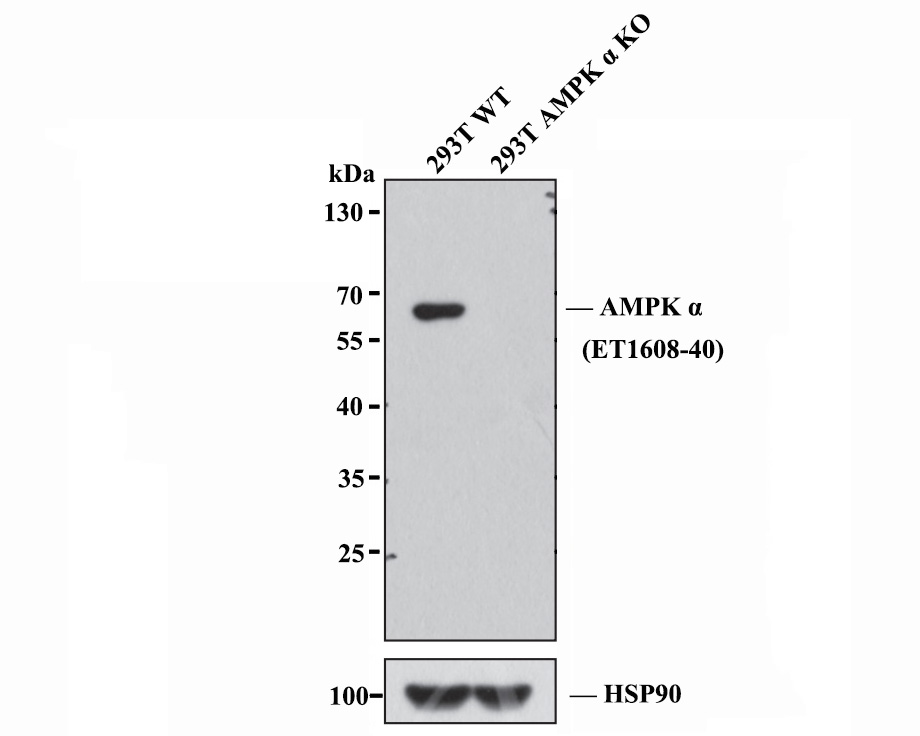
|
Fig3:
Western blot analysis of AMPK α with anti-AMPK alpha 1 antibody [SU03-48] (ET1608-40) at 1/5,000 dilution. Lane 1: Wild-type 293T whole cell lysate (20 µg). Lane 2: AMPK α knockout 293T whole cell lysate (20 µg). Proteins were transferred to a PVDF membrane and blocked with 5% NFDM in TBST for 1 hour at room temperature. The primary Anti-AMPK alpha 1 antibody (ET1608-40, 1/5,000) and Anti-HSP90 antibody (ET1605-56, 1/10,000) were used in 5% BSA at room temperature for 2 hours. Goat Anti-Rabbit IgG H&L (HRP) Secondary Antibody (HA1001) at 1/50,000 dilution was used for 1 hour at room temperature. |
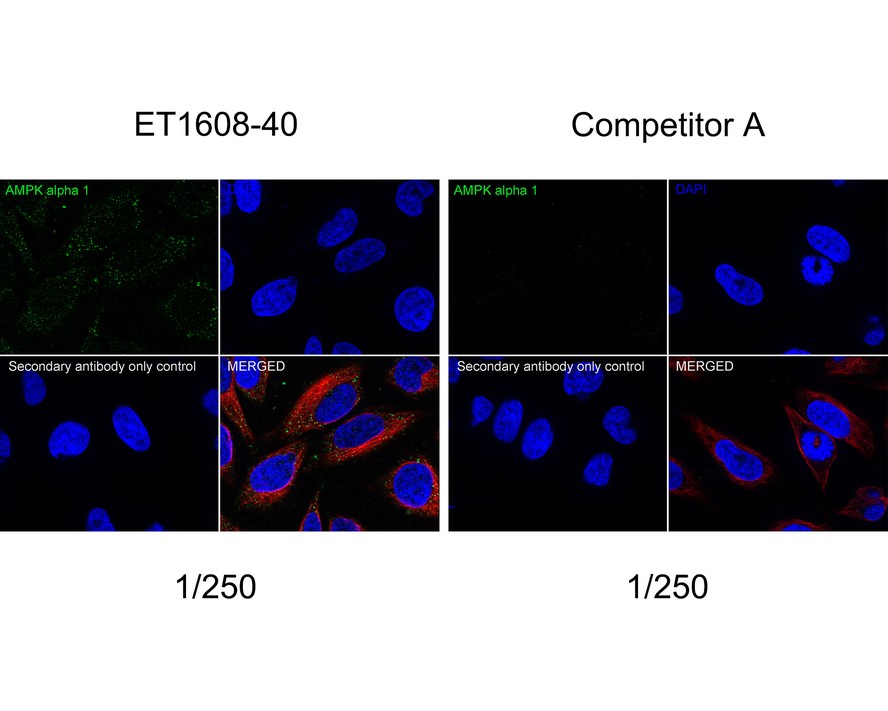
|
Fig4:
Immunocytochemistry analysis of HeLa cells labeling AMPK alpha 1 with Rabbit anti-AMPK alpha 1 antibody (ET1608-40) at 1/250 dilution and competitor's antibody at 1/250 dilution. Cells were fixed in 4% paraformaldehyde for 20 minutes at room temperature, permeabilized with 0.1% Triton X-100 in PBS for 5 minutes at room temperature, then blocked with 1% BSA in 10% negative goat serum for 1 hour at room temperature. Cells were then incubated with Rabbit anti-AMPK alpha 1 antibody (ET1608-40) at 1/250 dilution and competitor's antibody at 1/250 dilution in 1% BSA in PBST overnight at 4 ℃. Goat Anti-Rabbit IgG H&L (iFluor™ 488, HA1121) was used as the secondary antibody at 1/1,000 dilution. PBS instead of the primary antibody was used as the secondary antibody only control. Nuclear DNA was labelled in blue with DAPI. Beta tubulin (M1305-2, red) was stained at 1/100 dilution overnight at +4℃. Goat Anti-Mouse IgG H&L (iFluor™ 594, HA1126) was used as the secondary antibody at 1/1,000 dilution. |
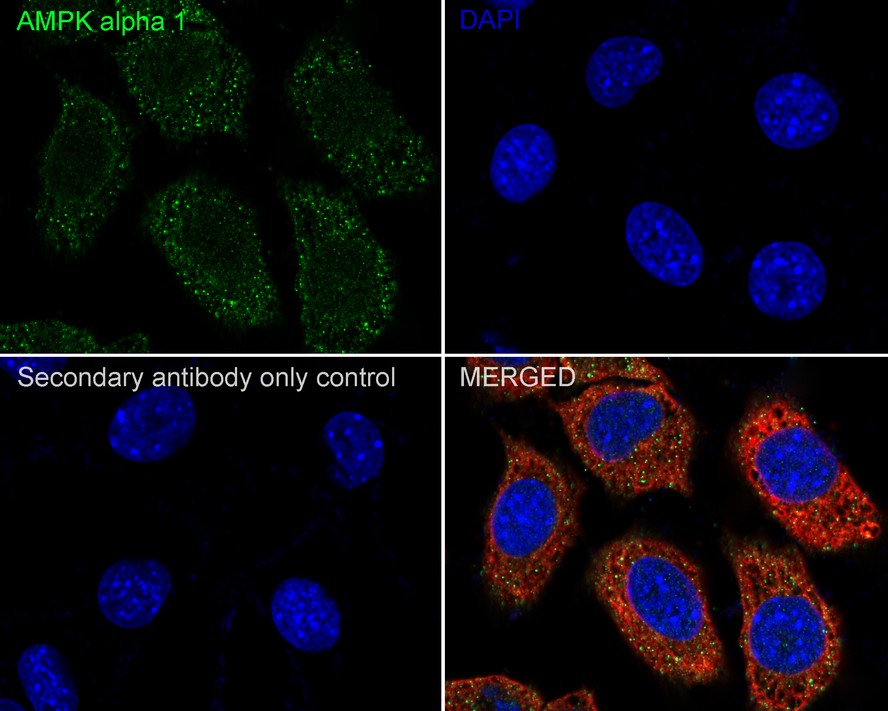
|
Fig5:
Immunocytochemistry analysis of L-929 cells labeling AMPK alpha 1 with Rabbit anti-AMPK alpha 1 antibody (ET1608-40) at 1/100 dilution. Cells were fixed in 4% paraformaldehyde for 20 minutes at room temperature, permeabilized with 0.1% Triton X-100 in PBS for 5 minutes at room temperature, then blocked with 1% BSA in 10% negative goat serum for 1 hour at room temperature. Cells were then incubated with Rabbit anti-AMPK alpha 1 antibody (ET1608-40) at 1/100 dilution in 1% BSA in PBST overnight at 4 ℃. Goat Anti-Rabbit IgG H&L (iFluor™ 488, HA1121) was used as the secondary antibody at 1/1,000 dilution. PBS instead of the primary antibody was used as the secondary antibody only control. Nuclear DNA was labelled in blue with DAPI. Beta tubulin (M1305-2, red) was stained at 1/100 dilution overnight at +4℃. Goat Anti-Mouse IgG H&L (iFluor™ 594, HA1126) was used as the secondary antibody at 1/1,000 dilution. |
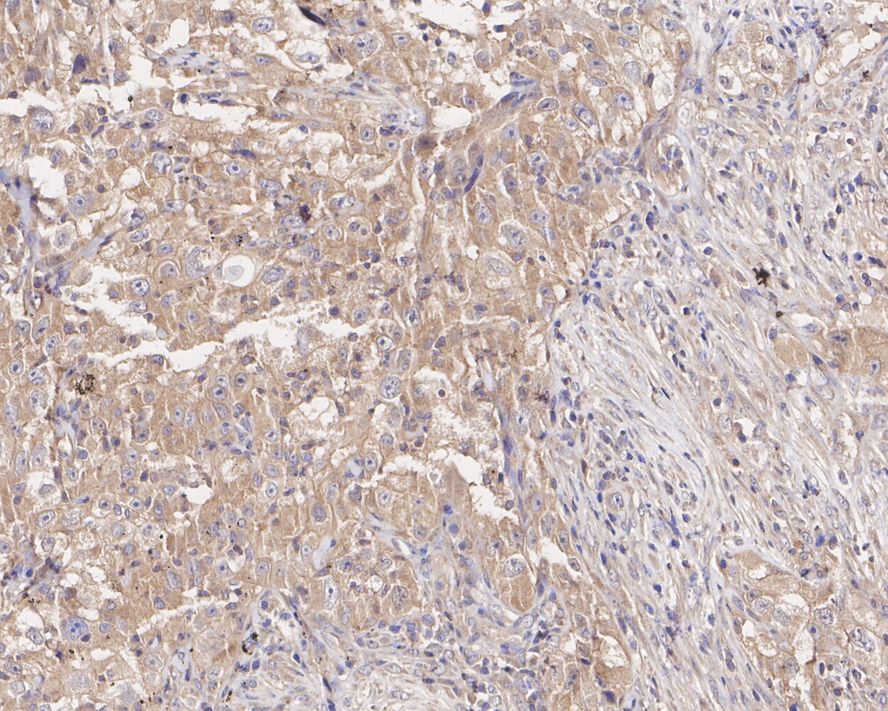
|
Fig6:
Immunohistochemical analysis of paraffin-embedded human lung cancer tissue with Rabbit anti-AMPK alpha 1 antibody (ET1608-40) at 1/1,000 dilution. The section was pre-treated using heat mediated antigen retrieval with sodium citrate buffer (pH 6.0) for 2 minutes. The tissues were blocked in 1% BSA for 20 minutes at room temperature, washed with ddH2O and PBS, and then probed with the primary antibody (ET1608-40) at 1/1,000 dilution for 1 hour at room temperature. The detection was performed using an HRP conjugated compact polymer system. DAB was used as the chromogen. Tissues were counterstained with hematoxylin and mounted with DPX. |
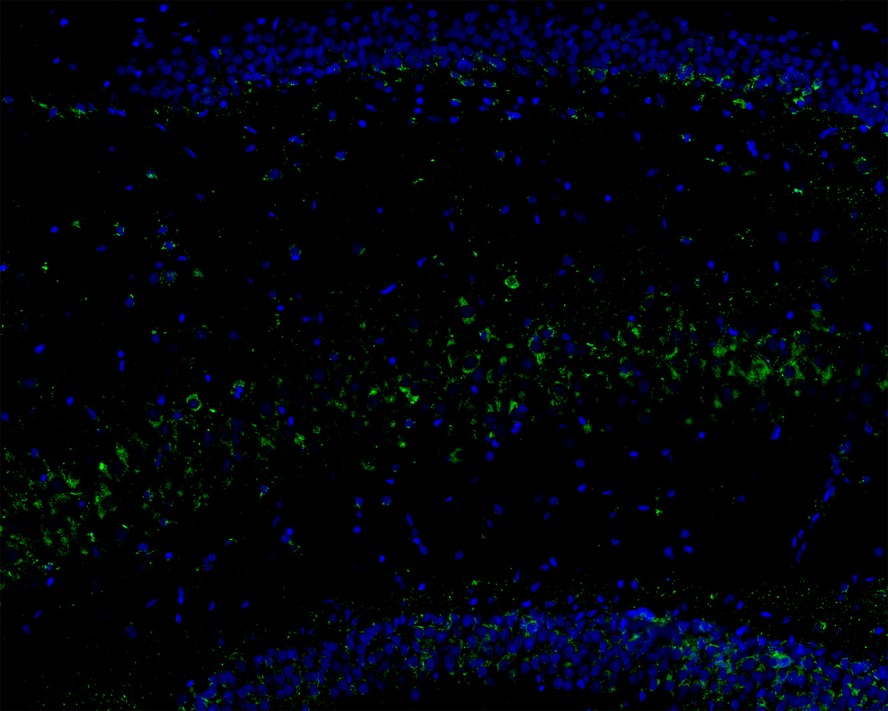
|
Fig7:
Immunofluorescence analysis of frozen mouse hippocampus tissue labeling AMPK alpha 1 with Rabbit anti-AMPK alpha 1 antibody (ET1608-40). The tissues were blocked in 3% BSA for 30 minutes at room temperature, washed with PBS, and then probed with the primary antibody (ET1608-40, green) at 1/100 dilution overnight at 4℃, washed with PBS. Goat Anti-Rabbit IgG H&L (Alexa Fluor® 488) was used as the secondary antibody at 1/200 dilution. Nuclei were counterstained with DAPI (blue). Image acquisition was performed with KFBIO KF-FL-400 Scanner. |
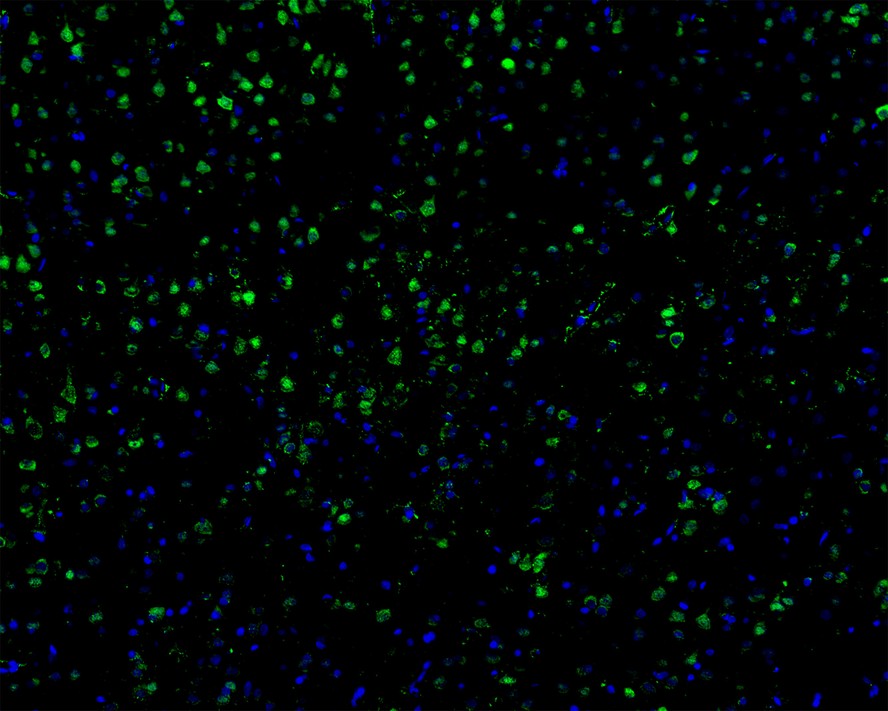
|
Fig8:
Immunofluorescence analysis of frozen mouse cerebral cortex tissue labeling AMPK alpha 1 with Rabbit anti-AMPK alpha 1 antibody (ET1608-40). The tissues were blocked in 3% BSA for 30 minutes at room temperature, washed with PBS, and then probed with the primary antibody (ET1608-40, green) at 1/100 dilution overnight at 4℃, washed with PBS. Goat Anti-Rabbit IgG H&L (Alexa Fluor® 488) was used as the secondary antibody at 1/200 dilution. Nuclei were counterstained with DAPI (blue). Image acquisition was performed with KFBIO KF-FL-400 Scanner. |
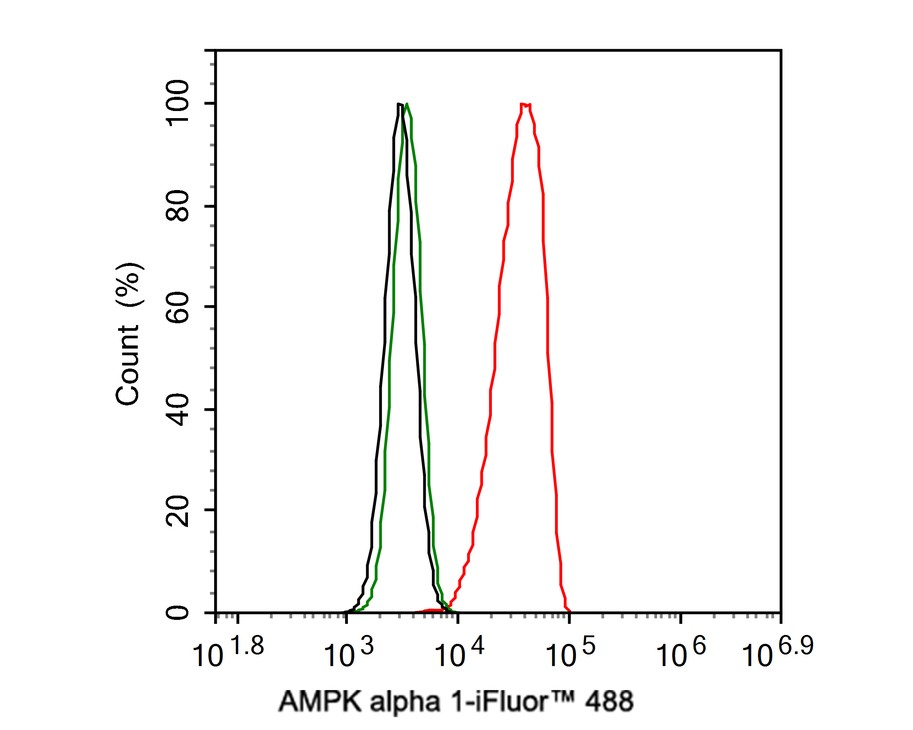
|
Fig9:
Flow cytometric analysis of HeLa cells labeling AMPK alpha 1. Cells were fixed and permeabilized. Then stained with the primary antibody (ET1608-40, 1ug/ml) (red) compared with Rabbit IgG Isotype Control (green). After incubation of the primary antibody at +4℃ for an hour, the cells were stained with a iFluor™ 488 conjugate-Goat anti-Rabbit IgG Secondary antibody (HA1121) at 1/1,000 dilution for 30 minutes at +4℃. Unlabelled sample was used as a control (cells without incubation with primary antibody; black). |
Note: All products are “FOR RESEARCH USE ONLY AND ARE NOT INTENDED FOR DIAGNOSTIC OR THERAPEUTIC USE”.